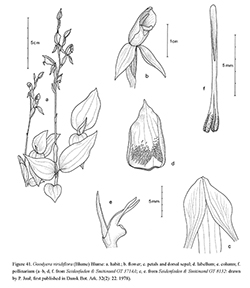e-Flora of Thailand
Volume 12 > Part 1 > Year 2011 > Page 78 > Orchidaceae > Goodyera
8. Goodyera viridiflora (Blume) Blume
Fl. Javae Nov. Ser: 34, t. 9c (fig. 2 & details 12–16). 1858 (1859?); Coll. Orchid.: 41, t. 9c (fig. 2 & details 12–16). 1858 (1859?); Seidenf., Dansk Bot. Ark. 32(2):20, fig. 6. 1978; J.B.Comber, Orchids Java: 31. 1990; Seidenf. & J.J.Wood, Orchids Penins. Malays. Singap.: 61, fig. 20g–i. 1992; J.B.Comber, Orchids Sumatra: 56. 2001; N.Pearce & P.J.Cribb, Fl. Bhutan 3(3): 88. 2002; Sitthisajjadham, Wild Orchids Thail. [in Thai]: 275, 2006; Orchid Guide Book 2 [in Thai]: 58 (bottom left), 138. 2007; S.C.Chen et al. in Z.Y. Wu et al. (eds), Fl. China 25: 50. 2009.— Neottia viridiflora Blume, Bijdr.: 408. 1825. Fig. 41; Plate IV: 1.
Accepted Name : This is currently accepted.
Synonyms & Citations :
Description : Flowering shoots 12–30 cm tall. Foliage leaves 4–8, herbaceous, crowded on the basal part of the stem, pale greyish-green with obscure dark green reticulation above, paler and shiny underneath; lamina cordate-ovate to ovate-elliptic, slightly oblique, acute to acuminate, (1.4–)2.5–8 by (0.8–)1.8–3.5 cm, margins often slightly undulate. Inflorescence cylindric to secund, lax, pubescent (sometimes sparsely so); rachis 3–9.2 cm long, 2- to 20-flowered; bracts (narrowly) lanceolate, acuminate, longer than or subequal to the ovaries, ciliate in their proximal half (otherwise glabrous), 11–23 by 2–8.5 mm. Flowers sessile, predominantly pale green to dull red with the apex of labellum white. Sepals glabrous; dorsal sepal boat-shaped, straight to slightly incurved, (oblong-)lanceolate, subacute, 3-veined, 6–16.2 by 3–6.1 mm; lateral sepals reflexed, shallowly boat-shaped, (oblong-)lanceolate, slightly falcate, subacute, 3-veined, 6–15.1 by 2–5.4 mm. Petals obliquely oblanceolate to spathulate-rhombic, obtuse to subacute, 6–15.8 by 2–5.6 mm. Labellum broadly ovate, 7–12.8 by 6.8–10.1 mm, concave with a flat, obtuse to acute, recurved to reflexed apex; the concave part with a large central (sometimes longitudinally split) tuft of fleshy hairs, devoid of other ornaments. Column 6.2–12.5 mm long (to apex of the very long rostellum); anther acuminate in front, 5.9–11.1 mm long. Ovary 6–15 mm long, subglabrous to sparsely pubescent. Capsule sessile, ovoid-fusiform, 13–19 mm long, 6–7 mm in diameter.
Thailand : NORTHERN: Chiang Mai (Doi Suthep), Phitsanulok (Phu Soi Dao); NORTH-EASTERN: Loei (Phu Kradueng); EASTERN: Chaiyaphum (Phu Khiao); CENTRAL: Nakhon Nayok (Khao Yai); PENINSULAR: Yala (Khao Pok Yo).
Distribution : NW Himalaya, Nepal, Bhutan, India (Assam), Myanmar, S China, Vietnam, Taiwan, Luzon, Ryukyu, Peninsular Malaysia, Sumatra, Java (type), Borneo, Sulawesi, Maluku, New Guinea, Queensland, SW Pacific Islands (east to Samoa).
Ecology : Shaded humus-rich ground in hill evergreen forests and bamboo thickets, mainly on granite or sandstone bedrock; 1,000–1,630 m alt. Flowering: recorded in May, July–August, October and December.
Vernacular : Ueang din dok mon (เอื้องดินดอกหม่น).


